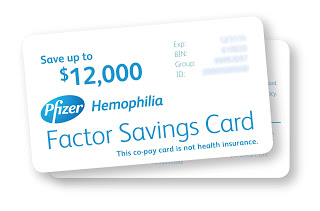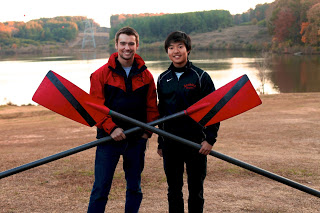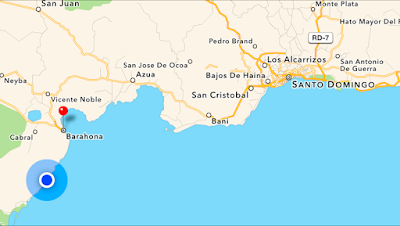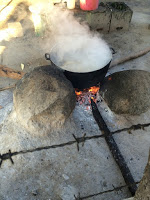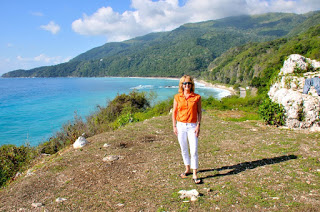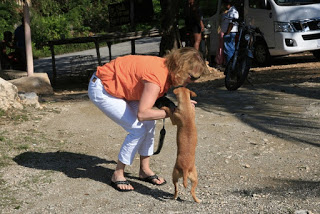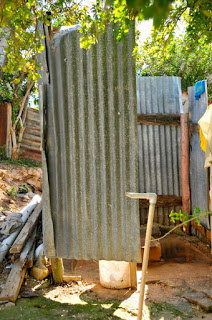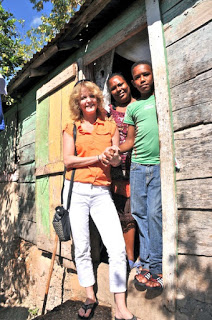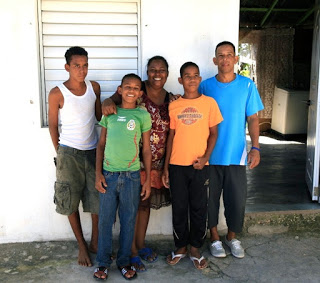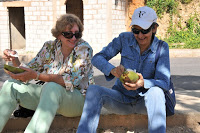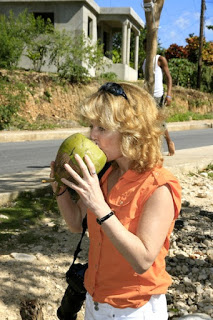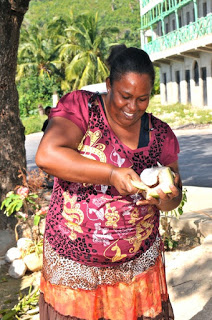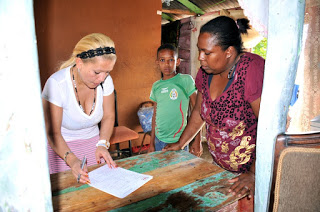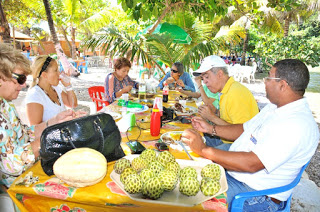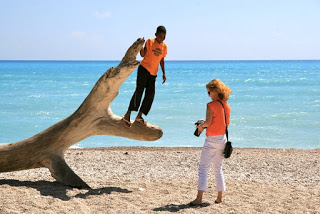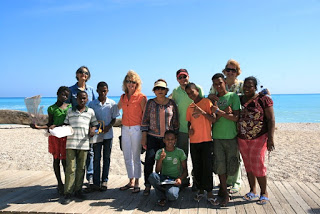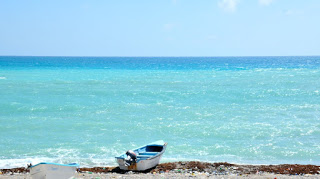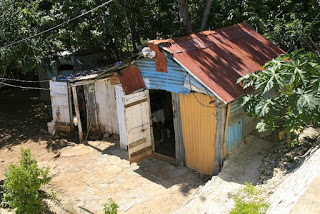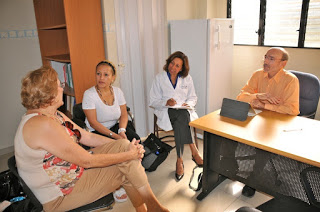 |
| Haydée, Zoraida, Rosa, Glenn
|
It’s been over two years since I’ve been to the Dominican Republic, the charming Spanish-speaking country of 10 million on the island of Hispaniola. When I first arrived in 1998, this impoverished country was struggling, trying to boost tourism and recover from a devastating hurricane that destroyed the landscape. Hemophilia care was almost nonexistent. The changes since then have been amazing; the country is a humming, frantically active hive of business, trade and tourism. And this trip was truly special.
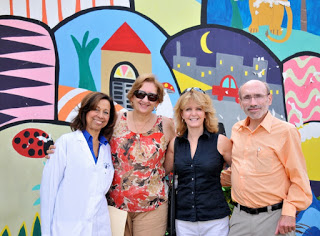 |
Dr. Rosa Nieves, Haydee de Garcia, Laurie Kelley,
Dr. Glenn Pierce |
My good friend and colleague Dr. Glenn Pierce was coming along. Glenn is one of the most impressive people in hemophilia: twice former president of the National Hemophilia Foundation; former vice president of clinical research at Bayer; former person with hemophilia (had a liver transplant); and most recently senior vice president medical and scientific affairs at Biogen. Glenn was responsible for overseeing the clinical studies of Eloctate and Alprolix, and brought those two revolutionary products to market.
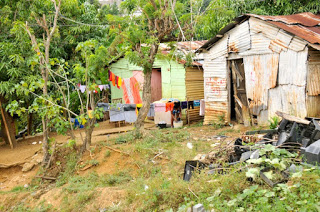 He left Biogen to get a knee replacement, and is now volunteering for the World Federation of Hemophilia. Glenn also sponsors children through Save One Life, the nonprofit child sponsorship program for children with hemophilia I founded.
He left Biogen to get a knee replacement, and is now volunteering for the World Federation of Hemophilia. Glenn also sponsors children through Save One Life, the nonprofit child sponsorship program for children with hemophilia I founded.
He wanted to come along one of our Save One Life trips, because they are very different than most other hemophilia trips. We make it a point to get into people’s homes, ground zero. For Glenn, this would be the first time he would visit impoverished people with hemophilia in their home environment. I chose the DR for him, as it’s the country I know best. After all, it was my first developing country too, in 1998. I entered the inner city two-room home of a woman called Santa then, who had twins with hemophilia, and entered a new world forever. It was like time traveling, and the trip changed my life.
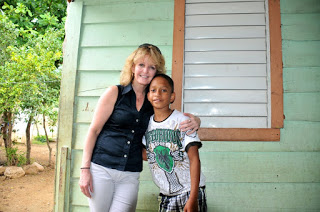 |
| Laurie Kelley and Angel |
Day 1 Wednesday January 27. I awake at the home of the president of the Fundación al Apoyo Hemofílico (FAHEM), which means the Hemophilia Help Foundation. Haydée is the mother of an adult son with hemophilia, and she founded FAHEM in 1995, two years before I met her. We’ve been friends and colleagues ever since. Over 19 years we’ve worked together to improve care for hemophilia on the DR.
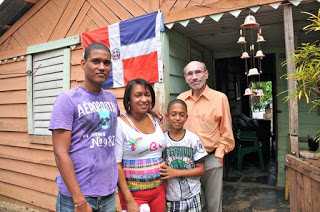 |
| Glenn meets with the Jimenez family |
Haydée and I had breakfast: fresh fried eggs and mangú, the delicious national dish. We picked up Glenn and Zoraida Rosado, program director for Project SHARE, at the nearby Marriott Courtyard. Our first meeting was with Dra. Rosa Nieves, pediatric hematologist at the Robert Reid Cabral Hospital. Zoraida translated as Glenn and Rosa spoke about the new prolonged half-life products, how they work, and then about the Biogen 1 million IU donation in particular. Glenn stressed the importance of reporting on all the product usage; documentation is essential to be considered for more product donation. It was a good meeting as Glenn could see first hand how Biogen’s donation was being distributed and monitored.
See our full gallery of photos of this trip.
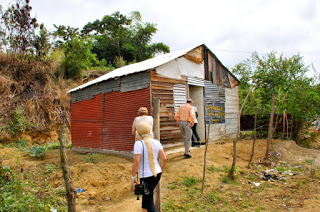 |
| To Gabriel’s House |
After this meeting we then drove out to see Andres and Angel Jimenez. They don’t live far away, but within 20 minutes outside of the throbbing streets of Santo Domingo everything changes. The jam-packed, bumper-to-bumper traffic lightens and turns into bumpy country roads, then dirt roads. This would be Glenn’s first visit ever to see an impoverished family in their home. I’ve been to this home 3 times now over the years.
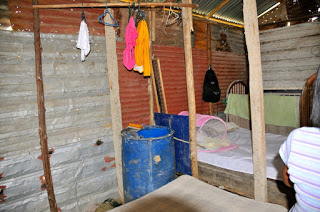 |
| Bed on a dirt floor; no screens, no latrine |
Soon we were at the house, a wood slat structure with a steel corrugated roof. The boys came out to greet us, smiling shyly. I am able to converse a bit in Spanish now, so said hello to the boys and asked how they’d been. After a tour of the house—three rooms, including a kitchen with a huge propane tank for cooking, a bedroom with one bed, and the narrow, dark living room, altogether no bigger than 20’x’16’ with no screens or luxuries, Angel and Glenn looked for chickens out back. Glenn chatted with the boys, with Zoraida translating. Angel is almost walking normally now, following surgery on his knee. Everyone is amazed when we tell them Glenn used to have hemophilia (a liver transplant cured him). We had some laughs, hugs, and I left a gift bag with the mom, and inside un regalo muy especial–$50. She seemed most pleased by the plush poodle Beanie baby I gave her!
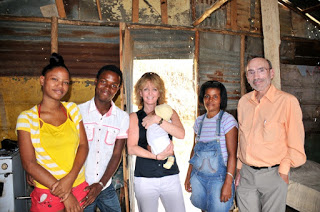 |
| Gabriel and girlfriend; Laurie Kelley holding newborn |
Afterwards, we headed to see Gabriel, a 20-year-old with hemophilia. He is propped on the back of a motorbike–no helmets of course–that whizzes along the dirt roads for 15 minutes, showing us the way to his house. Typical slat walls and steel roof. His mother Wanda is a live wire! Loud and animated, she commands attention when she walks in a room. After a brief visit, she pointed us down the road, to where her son Gabriel actually lives. We shuffled down the dirt road, passing several shacks, sun warmly toasting us, and approached Gabriel’s shack. Outside in the sunshine, a weakened puppy lay, same color as the dirt. It could only have been about a month old. I stooped to pet it, cradle his head; it looked up at me and leaned its head into my hand and licked my finger. I saw fleas scuttling through its fur, and the ants on the ground crawled freely over it. It had sores on it, poor baby.
Inside, a half cement, half dirt floor spread before us. Corrugated steel sides and top, no bathroom or even latrine. They do have electricity by jerry-rigging some wires from outside. The barest of possessions. Gabriel lives here with his girlfriend, and their baby, only a month old, like the puppy. I was able to hold him. I recall Gabriel from FAHEM’s summer camp about seven years ago, as a young teen. His leg then had been so mangled from bleeds, he had to hop/skip to get around. His walking is better now, but it’s hard for him to hold any job. He was doing some house painting, he told us, but a bleed kept him down, and the owner fired him. Currently he is unemployed. His Save One Life funds mean so much to him. Gabriel told me he used his Save One Life money to put in the concrete floor.
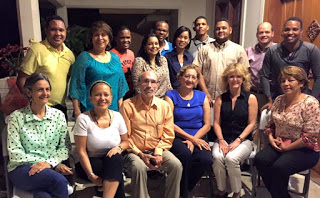 |
| Glenn meets FAHEM |
After this visit, we walked back to the SUV and jumbled back to the city. That evening, at Haydée’s casa, the FAHEM board members all came over. Everyone sat outside on the patio in the humid air: Fendi, Alfonso, Jonathan, Guillermo and Brahyan, Wicho, Mecho, and Dras. Joanne and Rosa. These men were all the boys I had first met in 1999, at our first camp, when they were only kids. Now they are mature adults, and future leaders. Haydée and her team are doing an excellent job at grooming them.
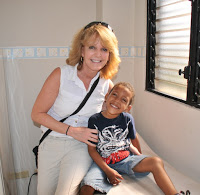 |
| Laurie Kelley meets José Luis! |
Glenn was able to chat with everyone, asking questions. Each person introduced themselves and shared something about their background, their struggles. They included how FAHEM turned their lives around. Everyone appreciated Glenn’s visit; we impressed on them that Glenn is an important person in the world hemophilia scene, and he chose to come to the DR to get a glimpse of how people actually live and struggle with hemophilia in developing countries. Part of the reason we chose the DR is that there is such a good team here: doctors, parents, patients, industry—everyone works together. It’s not like that in all countries and lack of teamwork hinder growth, progress and care.
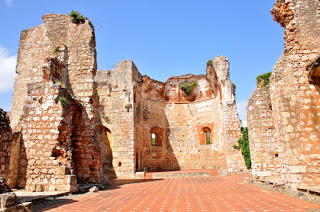 |
| First hospital in Americas, 1500s |
Day 2 Thursday January 28. This was our free day, to tour Santo Domingo, the capital city. The Colonial section downtown is so crowded now you can hardly park your car anywhere. We saw all the usual sights, buildings dating back to the 1500s, when the Spaniards were here. We saw the first street in the Americas, the first university, the first hospital in the New World. This is where Christopher Columbus landed in 1492, and where the conquest of the Americas began. It’s history is rich.
The food here is fabulous. I’m not a foodie, and could honestly survive on power bars, but here… fresh, abundant, delicious fruit and fish. The flavors are amazing. We took Glenn to a ritzy restaurant for lunch, and then three hours later, off to Boca Chica for dinner! The restaurant in Boca Chica is actually built on a pier, over the ocean, so you are surrounded by the waves as you eat. We all relaxed, chatted, enjoyed being in a foreign country, under the stars, surrounded by candles, hearing music, the roar of the sea against the beach. It was a lovely way to end the night.
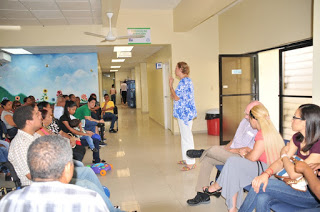 |
| Haydée lectures families |
Day 3 Friday January 29. This morning we stopped by the HTC at the hospital, where many families with hemophilia were gathered. I knew so many of the kids: Orlando, Socrates, Jhoan, Darling, Emmanuel. We exchanged hugs and kisses after a two year separation. Maria, Santa’s mother, came also. Santa now lives in Santiago; she was the first person in a developing country whose home I went into, in 1998. I still recall how sad her little home was, and she was putting away Christmas decorations, just a cheap plastic garland, that was all. I slipped the grandmother $40, which was all I had in cash.
Haydée lectured the families on various things concerning hemophilia, but especially the importance of coming to the HTC when they have a bleed. She rightly pointed out that many do not come, choosing to bleed, thinking that there is no factor. But now there is factor! The Biogen donation will last some time, and they should come and get treatment.
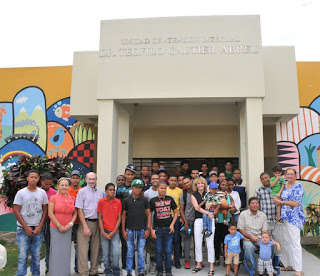 |
| The HTC and all the hemophilia families meet Glenn |
Glenn was introduced and Zoraida translated as he spoke. He mentioned the Biogen donation, how he was a part of that product development, and how important it was for everyone to report on the donation usage, so they would be eligible to get more.
Afterwards, photos, good byes, and we took Glenn to the airport to get his flight home. Haydée and I chose to relax later at her club by the ocean to have lunch. We were the only ones there. The Caribbean Sea was a sparkling jewel, the day warm. We rested on plastic chairs, admiring the peace and the serene waves. We shared a grilled parrotfish, which I’ve never eaten. It was a dark orange color, complete with head and eyes. It bore a row of very sharp teeth; it’s expression, popped-open-mouthed, looked like it was at once shocked and demeaned by being fried and eaten. Best fish I ever ate.
See our full gallery of photos of this trip.
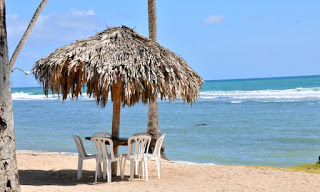 Part 2 next week! We go off on a 9 hour odyssey to meet one family.
Part 2 next week! We go off on a 9 hour odyssey to meet one family.

